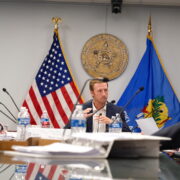
The landscape architect Michael Van Valkenburgh is a diviner of places, a city whisperer.
Though he had never set foot in Tulsa, he was coaxed to a flat, ho-hum stretch of land overlooking the Arkansas River by the billionaire philanthropist George B. Kaiser, who was bent on building a park.
Confronting this hodgepodge site with killer views of an oil tank farm and a power plant, Mr. Van Valkenburgh, who created Brooklyn Bridge Park, Maggie Daley Park in Chicago and other celebrated cityscapes, responded the way he typically does. “A limitation,” he will say about challenging terrain, “is the beginning of a gift.”
Seven years later, the Olmsted-style transformation of 66 acres in the central city is now Gathering Place, a much-anticipated $465 million park that opens Sept. 8 as one of the largest and most ambitious public parks ever created with private funds — and the latest example of deep-pocketed citizens rebuilding cities through projects they perceive to be in the public good.

At Gathering Place, play and landscape get equal billing. The wide range of park programs, which arose from a close engagement with the public, are the heart and soul of the project.
Even as the finishing touches are readied, it is a richly imagined landscape inspired in part by local limestone cliffs, in which a child can encounter a 22-foot-tall Great Blue Heron with a slide between her wings — one of more than 160 inventive play structures secreted among its groves, glades, vales and prairie-flowered hillocks.

 The project, which comes with a hefty $100 million endowment for maintenance and family programming, has been spearheaded and largely funded by the George Kaiser Family Foundation, with an assist from other donors. Its Tulsa-born namesake, Mr. Kaiser is a progressive Democrat in a sea of red who has devoted much of his philanthropic energy toward addressing intergenerational poverty in Tulsa, trying to level the playing field for children left behind by “the accident of birth.”
The project, which comes with a hefty $100 million endowment for maintenance and family programming, has been spearheaded and largely funded by the George Kaiser Family Foundation, with an assist from other donors. Its Tulsa-born namesake, Mr. Kaiser is a progressive Democrat in a sea of red who has devoted much of his philanthropic energy toward addressing intergenerational poverty in Tulsa, trying to level the playing field for children left behind by “the accident of birth.”
Mr. Kaiser has given away more than $1 billion over the past decade and signed the “Giving Pledge” launched by Warren Buffett and Bill and Melinda Gates that commits billionaires to donating at least half their assets to charity.


He is part of an expanding coterie of American tycoons who are forking over big philanthropic dollars for high profile civic spaces by star designers — among them “Diller Island,” an off-and-now-on-againperforming arts center on a Hudson River pier in New York underwritten by the billionaire Barry Diller and his fashion designer wife Diane von Furstenberg.
On a recent sultry morning, Mr. Kaiser, 76, was walking the park in a hard hat and a shirt with a plastic pocket protector for leaky pens, spouting statistics on dew points, quoting Monty Python and angsting about whether spending millions on a park best furthered equal opportunity for young children (“I feel guilt about everything I do,” he allowed). “We got more and more divided over time by geography, race and class,” he said of this city of 400,000. “So getting people together is step number one.”
A high-decibel preview of what Gathering Place might become was on display recently as about 150 children from the Tulsa Dream Center, a community nonprofit in the city’s underserved North Tulsa district, made a mad dash for four gigantic castle towers worthy of Rapunzel, connected by bouncy rigging.
Amaiah Jenkins, 10, emerged sweaty and panting after barreling down a slide positioned between two elephant tusks. “My favorite part is everything!” she enthused before making a beeline to a zip line in the trees.
For the entire article follow this link: www.nytimes.com










